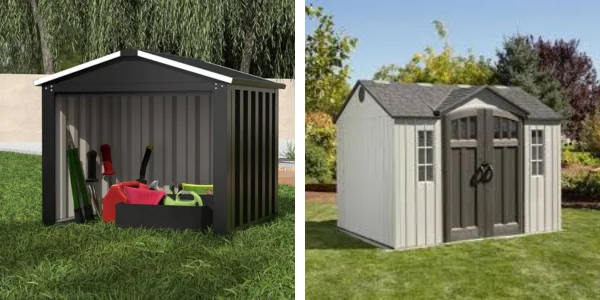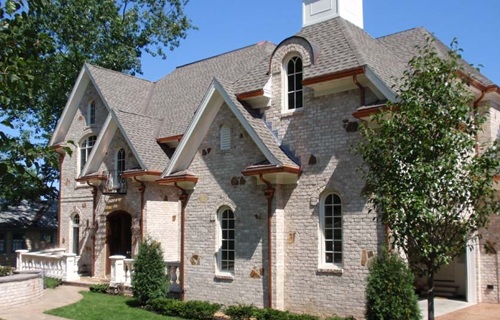When choosing a shed for your garden, backyard, or storage space, the decision often comes down to two popular materials — metal and plastic. Both have their unique advantages and drawbacks, so selecting the right one depends on your specific needs, budget, and environmental conditions.
In this detailed comparison, we’ll explore the key differences between metal sheds and plastic sheds to help you make an informed choice.
Overview of Metal and Plastic Sheds
Metal Shed
A metal shed is typically made from galvanized steel, aluminum, or corrugated metal. These sheds are valued for their strength, security, and durability.
Plastic Shed
A plastic shed, often made from resin or polyethylene, is designed to be lightweight, low-maintenance, and easy to assemble. Modern plastic sheds often mimic wood or other textures for a stylish appearance.
Key Differences Between Metal and Plastic Sheds

a) Durability and Strength
- Metal Shed: Known for its sturdiness, a metal shed can withstand strong winds, heavy rain, and accidental impacts better than plastic. However, metal can be prone to dents or rust over time.
- Plastic Shed: While plastic sheds are durable for typical weather conditions, they may struggle to handle heavy impacts or extreme weather as effectively as metal.
✅ Winner: Metal for better durability and impact resistance.
b) Weather Resistance
- Metal Shed: Offers good weather resistance but may be prone to rust or corrosion if not treated properly.
- Plastic Shed: Excellent resistance to water, UV rays, and humidity. Plastic sheds won’t rust, rot, or warp, making them ideal for wet or coastal climates.
✅ Winner: Plastic for superior weather resistance.
c) Maintenance
- Metal Shed: Requires regular maintenance, such as repainting to prevent rust and corrosion. Metal sheds may also need rust-proof coatings for long-term durability.
- Plastic Shed: Requires minimal maintenance. Simply washing with soap and water is enough to keep it clean.
✅ Winner: Plastic for lower maintenance needs.
d) Security
- Metal Shed: Offers better security against theft and break-ins due to its strong, rigid structure.
- Plastic Shed: While some plastic sheds are designed with durable locking mechanisms, they are generally easier to break into than metal options.
✅ Winner: Metal for superior security.
e) Assembly and Installation
- Metal Shed: Assembly can be complex and may require extra tools and manpower due to the heavier material.
- Plastic Shed: Typically easier to assemble, with lightweight panels that often snap together without advanced tools.
✅ Winner: Plastic for easier installation.
f) Aesthetics and Design
- Metal Shed: Often available in neutral tones like grey, green, or beige. While practical, metal sheds may not always offer the most appealing design.
- Plastic Shed: Available in a wider range of colors, textures, and styles, some of which mimic wood or stone for an attractive finish.
✅ Winner: Plastic for better design variety.
g) Cost
- Metal Shed: Typically cheaper upfront, especially for basic designs. However, long-term maintenance costs can add up.
- Plastic Shed: Slightly more expensive than metal but with lower maintenance costs in the long run.
✅ Winner: Metal for initial affordability; Plastic for long-term savings.
h) Environmental Impact
- Metal Shed: Steel and aluminum are often made from recyclable materials, making them an eco-friendly option if sourced responsibly.
- Plastic Shed: While plastic sheds require less energy to maintain, they are harder to recycle and may contribute to landfill waste.
✅ Winner: Metal for being more environmentally sustainable.
Pros and Cons of Metal Sheds
Pros
✅ Highly durable and impact-resistant
✅ Stronger security against break-ins
✅ Fire-resistant and less prone to warping
✅ Often more affordable initially
Cons
❌ Prone to rust and corrosion if not maintained
❌ Requires more effort during assembly
❌ Limited design options
Pros and Cons of Plastic Sheds
Pros
✅ Lightweight and easy to assemble
✅ Corrosion-resistant and ideal for humid areas
✅ Requires minimal maintenance
✅ Available in various designs and colors
Cons
❌ Less secure against break-ins
❌ May become brittle or discolored over time if exposed to extreme sunlight
❌ Higher initial cost
Which Option is Better for Different Needs?
Choose a Metal Shed If:
✔️ You need strong security for valuable tools and equipment
✔️ The shed will be placed in a protected area or dry climate
✔️ You’re looking for a budget-friendly solution
Choose a Plastic Shed If:
✔️ You prefer a low-maintenance storage option
✔️ The shed will be placed in a humid, coastal, or wet climate
✔️ You value design options and visual appeal
Cost Comparison: Metal vs Plastic Sheds
| Feature | Metal Shed | Plastic Shed |
|---|---|---|
| Initial Cost | $200 – $700 (for mid-range) | $300 – $1,000 (for mid-range) |
| Durability | Excellent | Good (May crack under impact) |
| Weather Resistance | Moderate (May rust) | Excellent (Water-resistant) |
| Maintenance | Regular upkeep required | Minimal maintenance |
| Security | Strong, rigid structure | Moderate security |
| Installation Ease | More complex | Easier setup |
Final Verdict: Which One is Better?
Choosing between a metal and plastic shed depends on your priorities:
- Choose a metal shed for better security, affordability, and strength.
- Choose a plastic shed for low maintenance, weather resistance, and aesthetic appeal.
For tool storage, gardening equipment, or secure workshops, a metal shed is ideal.
For a backyard storage solution, poolside shed, or stylish garden space, a plastic shed offers great versatility.
Expert Tip for Homeowners
Before purchasing a shed, consider factors like local weather, space requirements, and security concerns. Additionally, always check your area’s building codes or HOA rules to ensure your chosen shed meets local standards.
By evaluating your needs carefully, you can select the right shed that offers both functionality and long-term value for your property.

